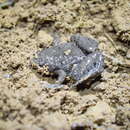en
names in breadcrumbs


Paradoxophyla palmata és una espècie de granota que viu a Madagascar.
Es troba amenaçada d'extinció per la pèrdua del seu hàbitat natural.
Paradoxophyla palmata és una espècie de granota que viu a Madagascar.
Es troba amenaçada d'extinció per la pèrdua del seu hàbitat natural.
Paradoxophyla palmata is a species of frog in the family Microhylidae. It is endemic to Madagascar. Its natural habitats are subtropical or tropical moist lowland forests, intermittent freshwater marshes, and heavily degraded former forest. It is threatened by habitat loss.
Paradoxophyla palmata is a species of frog in the family Microhylidae. It is endemic to Madagascar. Its natural habitats are subtropical or tropical moist lowland forests, intermittent freshwater marshes, and heavily degraded former forest. It is threatened by habitat loss.
Paradoxophyla palmata es una especie de anfibio anuro de la familia Microhylidae. Se encuentra en el este de Madagascar hasta los 950 m de altitud.
Paradoxophyla palmata es una especie de anfibio anuro de la familia Microhylidae. Se encuentra en el este de Madagascar hasta los 950 m de altitud.
Paradoxophyla palmata Paradoxophyla generoko animalia da. Anfibioen barruko Microhylidae familian sailkatuta dago, Anura ordenan.
Paradoxophyla palmata Paradoxophyla generoko animalia da. Anfibioen barruko Microhylidae familian sailkatuta dago, Anura ordenan.
Paradoxophyla palmata est une espèce d'amphibiens de la famille des Microhylidae[1].
Cette espèce est endémique de Madagascar. Son aire de répartition est clairsemée et concerne l'Est de l'île, aux altitudes comprise du niveau de la mer jusqu'à 950 m[1],[2].
Paradoxophyla palmata est une espèce d'amphibiens de la famille des Microhylidae.
Paradoxophyla palmata is een kikker uit de familie smalbekkikkers (Microhylidae). De soort werd voor het eerst wetenschappelijk beschreven door Jean Marius René Guibé in 1974. De soort behoort tot het geslacht Paradoxophyla.[2]
De kikker is endemisch in Madagaskar.[3] De soort komt voor in het oosten van het eiland en leeft in de subtropische bossen van Madagaskar op een hoogte van tot de 950 meter boven zeeniveau.
Paradoxophyla palmata is een kikker uit de familie smalbekkikkers (Microhylidae). De soort werd voor het eerst wetenschappelijk beschreven door Jean Marius René Guibé in 1974. De soort behoort tot het geslacht Paradoxophyla.
Paradoxophyla palmata é uma espécie de anfíbio da família Microhylidae.
É endémica de Madagáscar.
Os seus habitats naturais são: florestas subtropicais ou tropicais húmidas de baixa altitude, marismas intermitentes de água doce e florestas secundárias altamente degradadas.[1]
Está ameaçada por perda de habitat.[1]
Paradoxophyla palmata é uma espécie de anfíbio da família Microhylidae.
É endémica de Madagáscar.
Os seus habitats naturais são: florestas subtropicais ou tropicais húmidas de baixa altitude, marismas intermitentes de água doce e florestas secundárias altamente degradadas.
Está ameaçada por perda de habitat.
Paradoxophyla palmata là một loài ếch trong họ Nhái bầu. Chúng là loài đặc hữu của Madagascar. Các môi trường sống tự nhiên của chúng là các khu rừng ẩm ướt đất thấp nhiệt đới hoặc cận nhiệt đới, đầm nước ngọt có nước theo mùa, và các khu rừng trước đây bị suy thoái nặng nề. Loài này đang bị đe dọa do mất môi trường sống.
Phương tiện liên quan tới Paradoxophyla palmata tại Wikimedia Commons
Paradoxophyla palmata là một loài ếch trong họ Nhái bầu. Chúng là loài đặc hữu của Madagascar. Các môi trường sống tự nhiên của chúng là các khu rừng ẩm ướt đất thấp nhiệt đới hoặc cận nhiệt đới, đầm nước ngọt có nước theo mùa, và các khu rừng trước đây bị suy thoái nặng nề. Loài này đang bị đe dọa do mất môi trường sống.